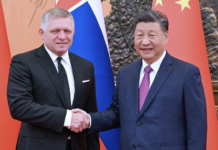Beijing, Dec 10 — Recovery momentum in major sectors drives expansion, says KPMG report
China’s GDP growth rate is expected to touch 8.8 percent in 2021, thanks to the robust recovery momentum seen in major economic sectors, global consultancy KPMG said in a report.
With per capita disposable income of Chinese people returning to the positive territory during the third quarter of the year, consumption has also been staging a rebound. Consumer optimism and the normalization of the COVID-19 epidemic control and prevention measures will further unlock the offline shopping potential in the subsequent months. The continued turnaround in consumption and service sectors will be the major economic driver next year, said Kang Yong, chief economist at KPMG China.
As outlined in the 14th Five-Year Plan (2021-25) proposals, manufacturing, especially the high-end manufacturing sector, will become a major driving force of China’s long-term economic growth. KPMG expects the development of high-tech manufacturing and industrial upgrades to stimulate investment over the next 12 months. As privately owned enterprises account for 90 percent of China’s manufacturing sector, stronger investment data on manufacturing will reflect the improvement of the private sector, said Kang.
Data from the General Administration of Customs showed that China’s export value increased by 2.4 percent on a yearly basis during the first 10 months of this year, exceeding market expectations. But the value of the global trade in goods contracted by 14 percent on a yearly basis during the first six months, according to World Trade Organization estimates.
Some of the global orders transferred to China this year, thanks to the country’s earlier recovery from the pandemic, have fueled the surge in exports, said Kang. Since the demand gap still exists in some overseas markets due to the pandemic, China’s export value will remain at a relatively high level next year, he said.
While concerns were being expressed on foreign investment as the pandemic spread globally at the beginning of the year, the value of actually utilized foreign capital grew by 6.4 percent on a yearly basis in China in the first 10 months. As estimated by the United Nations Conference on Trade and Development, global foreign capital investment will slump by up to 40 percent this year.
“China’s large and rapidly expanding market, combined with its complete industrial system, high-quality infrastructure and deepened opening-up policies, are all huge attractions for foreign capital. While many industrial chains were hit by the pandemic, the resilience of the supply chains will top the company’s global mapping agenda and prompt adjustments,” said Kang.
Meanwhile, KPMG also foresees continued financial opening-up in 2021, which will further facilitate overseas investment in renminbi-denominated financial assets. Therefore, the renminbi exchange rate will likely remain stable next year, promising some room for appreciation. But companies must also keep an eye on the changes in monetary and fiscal policies, KPMG said.
With the official signing of the Regional Comprehensive Economic Partnership agreement on Nov 15, economic cooperation in the Asia-Pacific region will be further strengthened next year, said Kang. The regulations regarding tariff, investment negative list and e-commerce specified in the RCEP agreement will further consolidate the economic and trade ties among member states, which are conducive to more flexible industrial mapping within the region, said Kang.
Nicholas Yeo, head of China equities at Aberdeen Standard Investments, also confirmed the positive outlook on the improved profitability of Chinese companies, thanks to the earlier recovery of the economy. Structural growth impetus from consumption, new technologies and green energy will further elevate the market performance, he said.
Given China’s steadily growing GDP, market giant BlackRock said in its 2021 investment report that China is a “distinct pole of global growth”, which is also “an investment destination separate from emerging markets”.
















